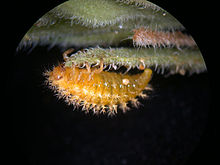Epilachninae
Cynegetini[1] Epilachnini Epivertini Eremochilini The Epilachninae are a subfamily of the family of lady beetles, the Coccinellidae, in the order Coleoptera.
[2] The taxonomy of the Epilachninae is constantly in flux, and while little disagreement exists about their status as members of the Coccinellidae, various authors disagree widely in their classifications; some recent authors treat them as a tribe (or series of tribes) within the subfamily Coccinellinae (e.g.[1]), but the most recent phylogenies provide evidence that the group is a monophyletic subfamily.
[5] Questions have been raised as to whether the single known species of Subcoccinella belongs in the Epilachninae at all; it has been included in the tribe Epilachnini on the grounds of morphology, in particular the herbivorous mouthparts, but the resemblance may have arisen by adaptation to plant feeding.
[6] The Epilachninae are most notorious as pests of crops in the families Solanaceae and Cucurbitaceae, but as a group they feed on a much wider range of plants.
A larva generally passes through five instars in a period of four to five weeks, after which it will anchor itself to a suitable surface, usually in a protected spot on the plant, where it changes its skin once more, forming a typical coccinellid pupa, from which it emerges as a beetle imago after several days.
Commonly, such species have the remarkable habit, which also occurs in some other coccinellid subfamilies, of migrating tens of kilometres to the highest point on a nearby ridge or peak, hibernating or aestivating in masses.


